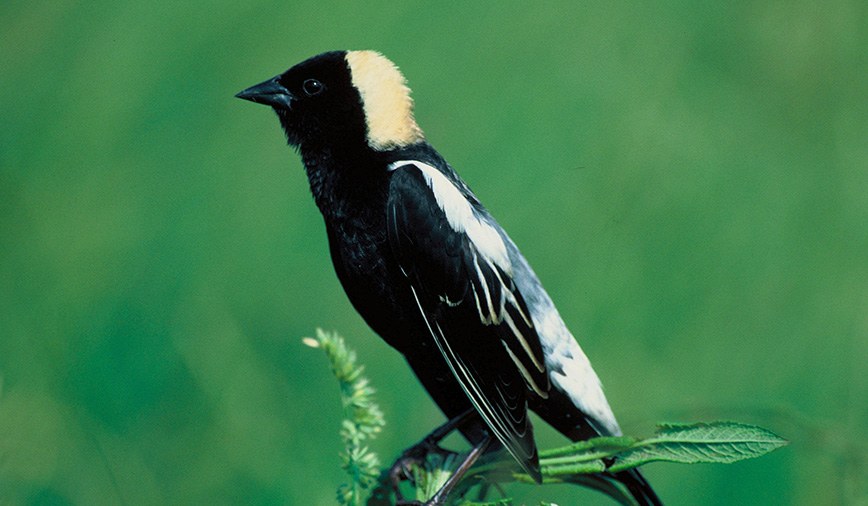This time of year there’s lots to see in Bobolink Field, a natural area just west of the Illinois Youth Center in St. Charles. Managed by the St. Charles Park District, the gently rolling field features many species of native grasses and forbs, plus mammals, birds, herps (reptiles and amphibians) and insects galore.
In fact, there’s really only one thing missing in Bobolink Field this year: the bobolinks themselves. Which is really a shame.
Bobolinks, if you’ve never seen them, are a sight to behold. With an all-black front and a white back, males in breeding plumage look like a groom whose pre-wedding jitters caused him to slip his tuxedo on backwards. Add to this a shock of yellow on the back half of his head, and you’ve got one unmistakable bird.
Besides their flashy courtship colors, bobolinks also are remarkable for the distance they travel between breeding and wintering grounds. Whereas summers may be spent here in St. Charles, or even as far north as southern Canada, the birds’ migration route south takes them down, down, down to southwestern Brazil and northern Argentina—a distance of some 6,000 miles.
And then there’s the singing. Males declaring territory can produce a dazzling jabber of squeaks, tinkles and melodic burbles, sung over and over again. Ornithologist A.C. Bent may have said it best when he described the notes as “a bubbling delirium of ecstatic music that flows from the gifted throat of the bird like sparkling champagne.”
Over the past several years, Bobolink Field has been carefully managed to promote the sort of habitat that grassland birds like bobolinks prefer—moderate to tall herbaceous vegetation that is somewhat dense, without shrubs or trees. Just as important, or perhaps more so, is adequate duff—the accumulation of past years’ dead plant material, roughly equivalent to the thatch that forms in suburban yards. Bobolinks nest on the ground, among the duff; without it, the birds would be without cover—like proverbial sitting ducks.
Denis Kania, the park district’s natural areas manager and an avid birder himself, says he actually had Henslow’s sparrows, another grassland species, in mind when developing the management plan for the field, but notes that bobolinks have been nesting in the field for years. Like many management plans, this one includes prescribed burns. Such burns are conducted under closely monitored conditions, and never during bird breeding seasons. They also are spaced so that only a few portions are burned at any one time; leaving other parts untouched ensures that sufficient amounts of the all-important duff are preserved.
So with a management plan in place, and with several years of successful bobolink breeding to its credit, why is Bobolink Field home to only one or two lone males this year? The answer to this burning question is, well, burning.
Someone other than Denis and his restoration crew took it upon themselves to set Bobolink Field on fire. They chose a warm, early spring day when the wind speed and humidity were just right, dropped a match and, poof! Many years of diligent natural-area management went up in smoke.
When the bobolinks returned in early May, the field was greening up, but the birds knew something was amiss. Denis says he spotted a few at another area field, but adds that they have since moved on. And when he and I walked the field a week ago, we spotted only two males, and neither appeared to be guarding any nests.
Where did the bobolinks go? We don’t know. Will they be back? We don’t know that either. What we do know is that bobolink numbers, like those of many other grassland bird species, are decreasing at alarming rates. Habitat destruction is a primary factor in the decline, and cases of arson like what we’ve experienced only make things worse.
If you happen to be walking at Bobolink Field, which can be accessed through West Side Community Park (formerly Campton Hills Park), and happen to see any sort of suspicious, potentially arson-related activity, please let us know. Maybe, working together, we can put an end to this troubling and illegal activity.
Pam Otto is the manager of nature programs and interpretive services for the St. Charles Park District. She can be reached at potto@stcparks.org or 630-513-4346.

